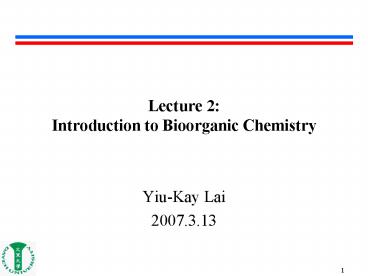Lecture 2: Introduction to Bioorganic Chemistry - PowerPoint PPT Presentation
1 / 18
Title:
Lecture 2: Introduction to Bioorganic Chemistry
Description:
A biomolecule is a chemical compound that naturally occurs in living organisms. ... is asymmetric, or polar, and the oxygen atom is said to be electronegative. ... – PowerPoint PPT presentation
Number of Views:937
Avg rating:5.0/5.0
Title: Lecture 2: Introduction to Bioorganic Chemistry
1
Lecture 2Introduction to Bioorganic Chemistry
- Yiu-Kay Lai
- 2007.3.13
2
Chemistry of Biomolecules
- A biomolecule is a chemical compound that
naturally occurs in living organisms. - Biomolecules consist primarily of carbon and
hydrogen, along with nitrogen, oxygen, phosphorus
and sulfur. - Other elements sometimes are incorporated but are
much less common.
3
The Six Most Abundant Elements of Life
???????????
4
Valence ?
- Each element has a characteristic valence that
determines the number of covalent bonds it can
form. - A shared electron pair is called a covalent bond
(???). The number of covalent bonds that each
element can form is called its valence.
5
Organic Molecules Hydrocarbons
Hydrocarbons (?????), the simplest organic
molecules, contain only carbon and hydrogen atoms.
6
Isomers
- Organic molecules exist in three-dimensional
space, and the same set of atoms can be put
together in many recognizably different ways,
resulting in molecules called isomers. - ???????,?????????
- 1. Structural isomers Variations in the
position at which different atoms are joined
together. - 2. Geometric isomers Variations in the
placement of atoms around carbon atoms joined by
double covalent bonds. - 3. Enantiomers Left-handed and right-handed
variations resulting from the tetrahedral
geometry of carbon.
7
Isomers
(a) Structural isomers
(b) Geometric isomers
(c) Enantiomers
8
Enantiomers are important in the pharmaceutical
industry
9
Polarity ??
Many combinations of different elements Result in
unequal electron sharing, called polar
bonding. The sharing of electrons in covalent
bonds is not always equal. In a covalent bond,
atoms such as oxygen contain a higher
localization of negative charge density than
their atomic partners. As a result, the electron
distribution is asymmetric, or polar, and the
oxygen atom is said to be electronegative. This
asymmetry results in regions of slight negative
and positive charge in different regions of the
molecule, denoted by the Greek symbol d, for
"partial" charge.
10
The Functional Groups
The properties of different biological molecules
depend on certain characteristic groupings of
atoms called functional groups. The names of the
six most important functional groups are
- Hydroxyl
- Carbonyl
- Carboxyl
- Amino
- Sulfhydryl
- Phosphate
11
Hydroxyl Group
OH
- In a hydroxyl group (OH), a hydrogen atom is
bonded to an oxygen atom, which in turn is bonded
to the carbon skeleton of the organic molecule.
(Do not confuse this functional group with the
hydroxide ion, OH). - Hydroxyl groups are not highly reactive, but they
readily form hydrogen bonds and contribute to
making molecules soluble in water. - Alcohols and sugars are "loaded" with hydroxyl
groups.
12
Carbonyl Group
- Carbonyl group consists of a carbon atom joined
to an oxygen atom by a double bond (symbolized as
CO). - Like hydroxyl groups, carbonyl groups contribute
to making molecules water-soluble. All sugar
molecules have one carbonyl group, in addition to
hydroxyl groups on the other carbon atoms.
13
Two Forms of Carbonyl Groups Aldehydes and
Ketones
Propanal, an aldehyde
Acetone, a ketone
- Aldehyde groups, where the CO group is at the
end of an organic molecule. A hydrogen atom is
also located on the same carbon atom. - Keto groups, where the CO group is located
within an organic molecule. All sugars have
either a keto or an aldehyde group. - An aldehyde and a ketone may be structural
isomers with different properties, as is the case
for acetone and propanal.
14
Carboxyl Group (Acids)
Acetic Acid
Acetate
- The carboxyl group (symbolized as COOH) has both
a carbonyl and a hydroxyl group attached to the
same carbon atom, resulting in new properties. - Carboxyl groups are weak acids, dissociating
partially to release hydrogen ions.
15
Amino Group (Bases)
- The amino group (NH2) consists of a nitrogen
atom bonded to two hydrogen atoms and to the
carbon skeleton. - Acts as a base can pick up a proton from the
surrounding solution. - Ionized, with a charge of 1, under cellular
conditions.
16
Sulfhydryl Group
SH
- The sulfhydryl group (SH) consists of a sulfur
atom bonded to an atom of hydrogen resembles a
hydroxyl group in shape. - Two sulfhydryl groups can interact to help
stabilize protein structure called disulfide bond
(symbolized as -S-S-).
17
Phosphate Group (Acids)
- In a phosphate group, a phosphorus atom is bonded
to four oxygen atoms one oxygen is bonded to the
carbon skeleton two oxygens carry negative
charges abbreviated P . The phosphate group
(OPO32-) is an ionized form of a phosphoric acid
group (OPO3H2 note the two hydrogens). - Makes the molecule of which is a part an anion
(negatively charged ion). - Can transfer energy between organic molecules
(e.g., ATP).
18
The Functional Groups
- Functional groups are the chemically reactive
groups of atoms within an organic molecule. - Give organic molecules distinctive chemical
properties. - Most Important in the Chemistry of Life































